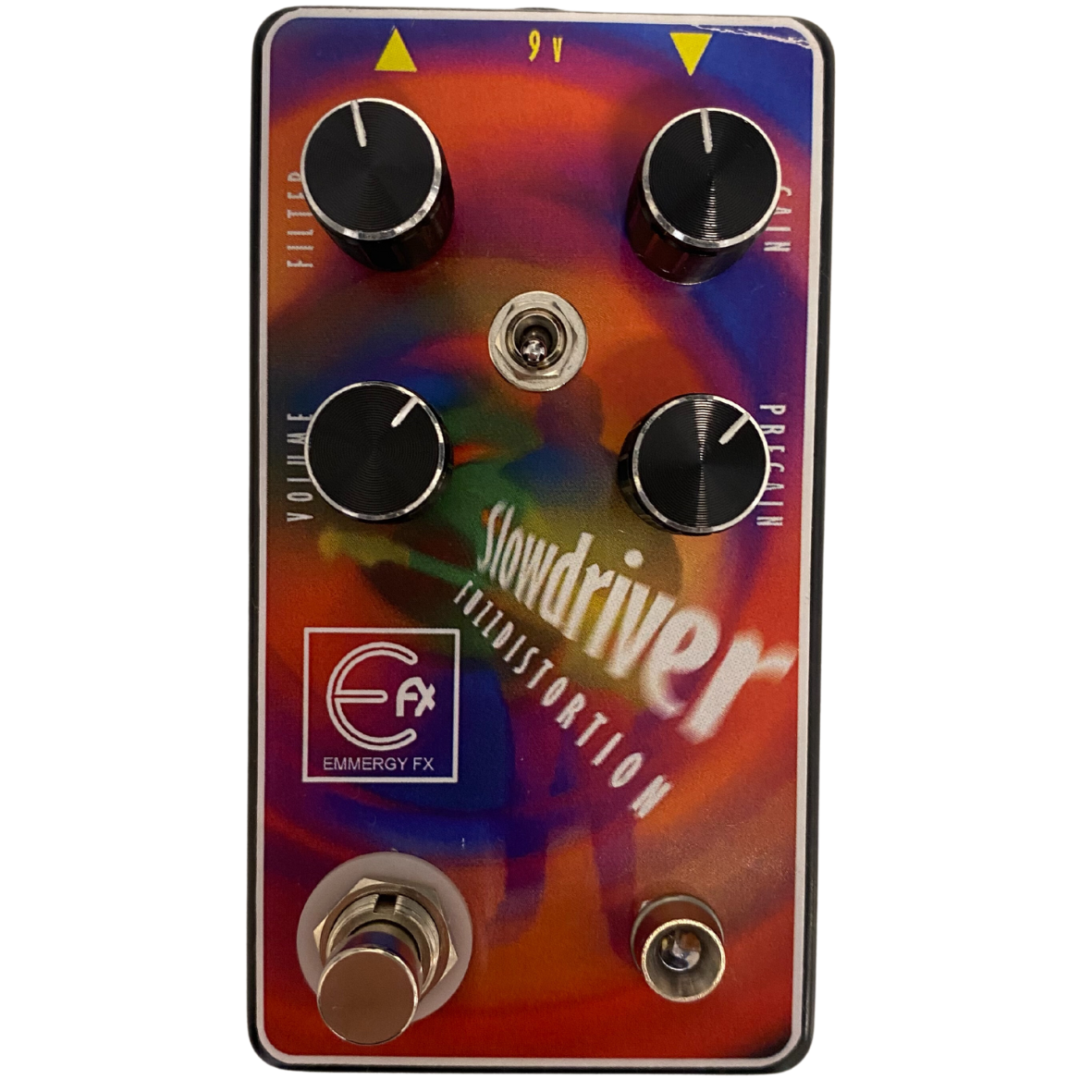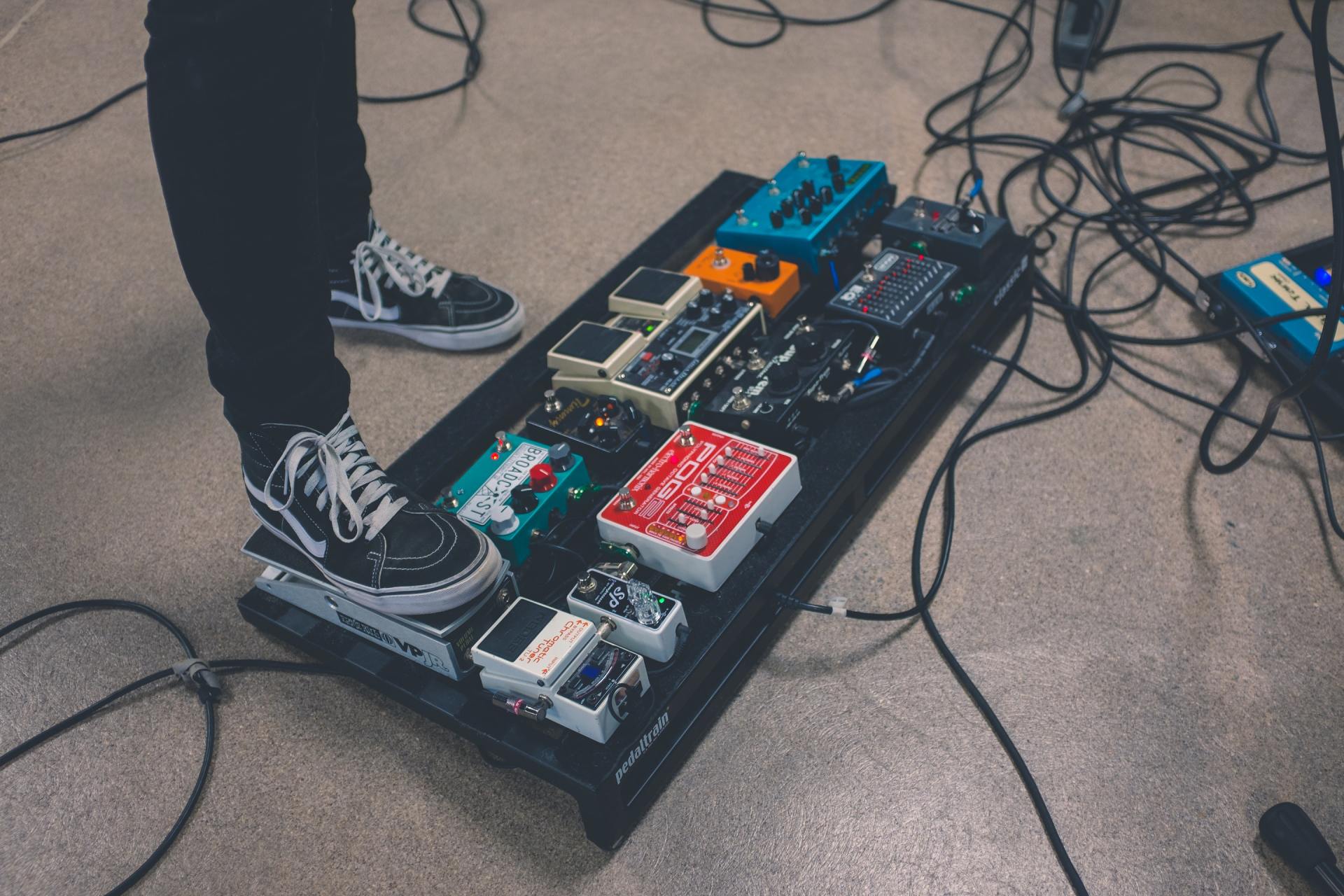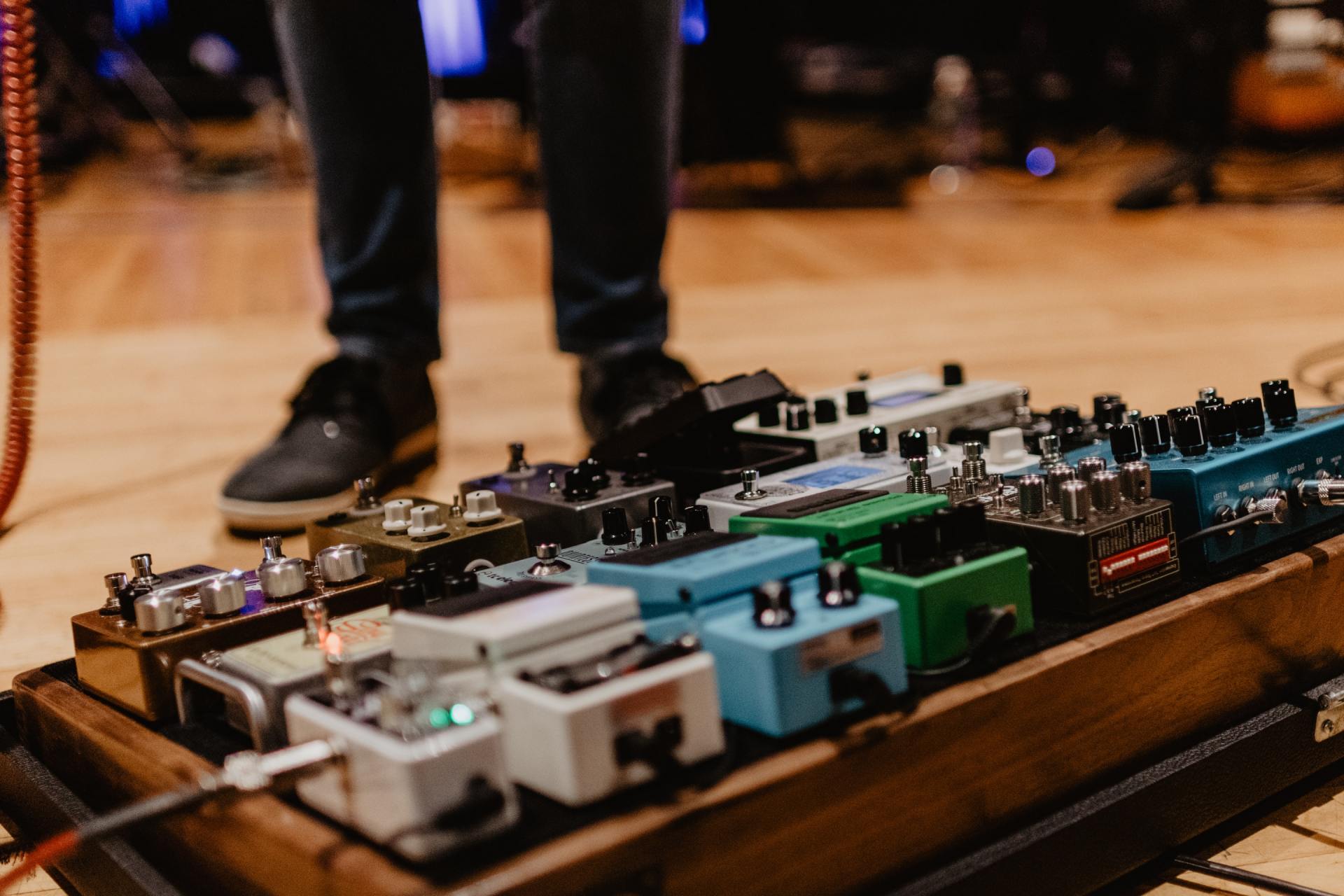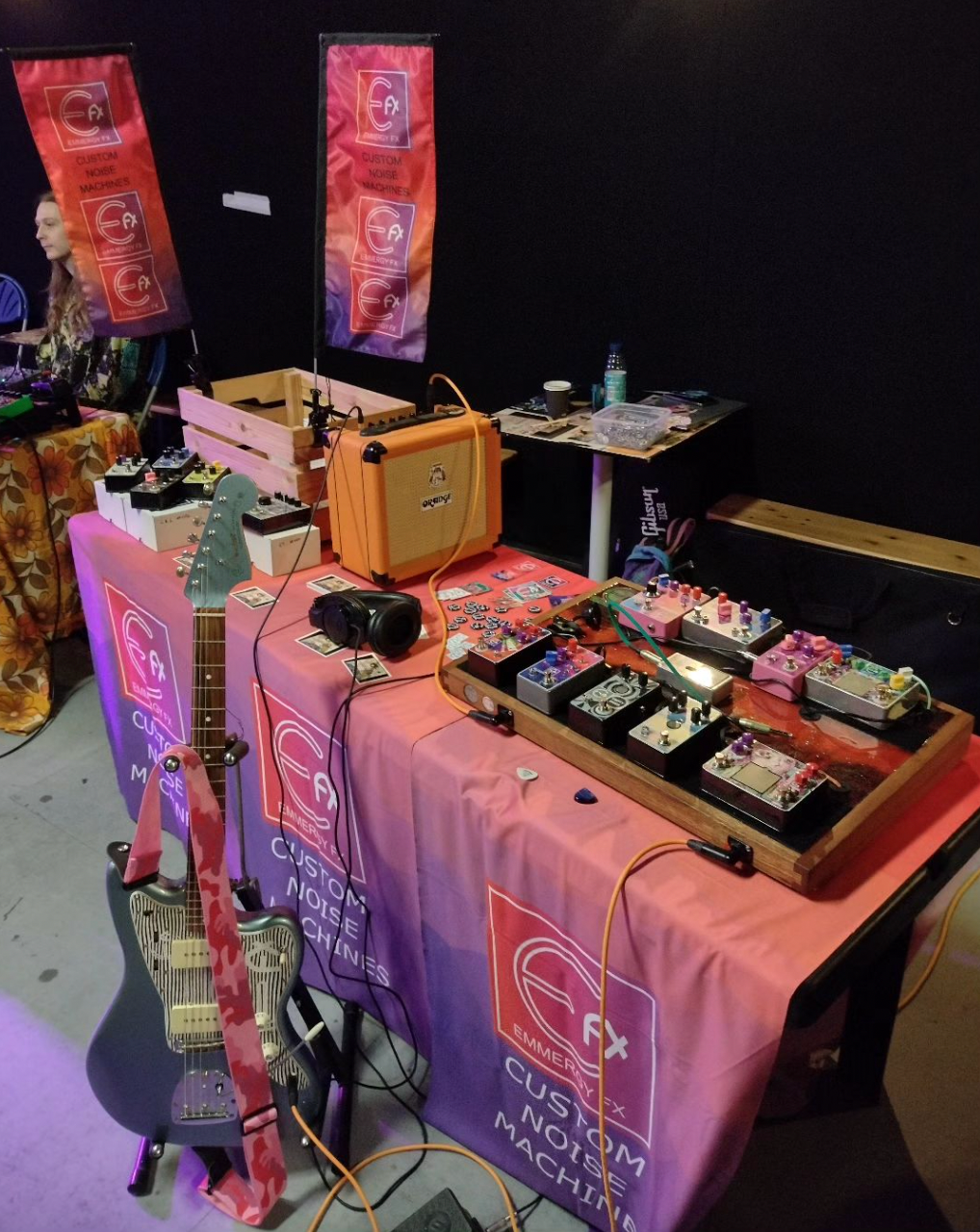Pedals - stuff about pedals
Pedal Construction at Emmergy FX
Pedals have moved on a lot in the last few years, with amp modellers, multi-effects, DAW plug-ins, and amp/effects combos, so you have a lot to choose from. At Emmergy FX we like to take things back to the old skool way of doing things. Tirelessly testing circuits with different parts to make sure every design achieves the best possible sound with the perfect control to push your playing into new territory.
Once the circuit is finely tuned to satisfaction it can become a working pedal. This, we believe, is where our products shine over mass produced units. Every single one of our pedals is hand crafted, one at a time so that each one gets the same level of attention and detail, using a method rarely used these days.
Most independent and boutique pedal builders will turn their circuit into a printed circuit board design and get pcb’s manufactured. This is a totally acceptable and modern solution that cuts down the build time of each unit and means the cost of building the pedals can be reduced. At Emmergy we take a different approach though. By deciding to not use pcb’s we are not relying on a third party manufacturing process where mistakes can be made in the tiny traces in the board that connect the components. Instead, we solder our circuits point to point. Basically taking two components that are directly touching each other and soldering that to a terminal strip so the parts remain firmly connected for life and are securely held in place within the pedal.
This takes time. Care must be taken adding every component as they cross and overlap each other but it means there is nowhere to hide. Every connection remains true and solid forever with no hidden connections. We also choose to use terminal strip architecture rather than ‘spider-leg’ construction as the latter can be a little vulnerable to abuse, whereas the terminal strips ensure a rigid circuit that is separated from the footswitch and jack sockets with wires.
This means we can guarantee your pedal will be ready to use and sound amazing every time you use it for life. In fact we do guarantee all our pedals with a ‘repair or replace’ policy for life so if anything at all goes wrong with your pedal we will fix it or send you a new one.
A bit about the types of effect pedals
WHAT IS DISTORTION?
Where overdrive is designed to sound like turning a valve amp up loud, distortion pushes that same theory to its ultimate level by mimicking using a valve amp at FULL volume.
The line between overdrive and distortion is very thin. At Emmergy FX we design our overdrive pedals to have a bit more gain than most. Does that actually make them distortion pedals. No, we don't think so because they are capable of anything from light overdriven tones through to all out distortion and slightly beyond. Perhaps they are better referred to as 'drive' pedals
WHAT IS AN OVERDRIVE?
It is the closest you can get to amplifier drive without actually blowing your roof off and making your neighbours hate you. Essentially, an overdrive pedal is designed to give you the same dynamics that you get when you play a cranked tube amp. The effect responds so much to your touch. Play softly, you’ll have a mostly clean sound, but play hard your signal starts to break up.
It is there to add a smooth, dynamic sound but can be made to melt faces. You may think this makes overdrives suited to say blues or britpop, which is true, but you can get so much more depending on pedal settings and components used. Just ask Misha Mansoor of the band Periphery. He is directly responsible for the Horizon Devices Precision Drive, a pedal designed around a tubescreamer overdrive but adapted for people who play tight metal on a 7 or 8 string guitar. At Emmergy FX we currently make two overdrive pedals. They are very different from each other. The Weight Gainer whose simplicity and ultra high gain capabilities are it’s unique features, and the Phosphocreatine which has a thicker, versatile sound. Both have a unique flavour and yet both are suited to lots of different styles of playing.
Try some shoegaze vibes by adding a reverb after them, or set the roof trembling with some all out monstrous punk. Other overdrives we would recommend include the Hot Knife from Electric Squid Industries, the Broadcast from Hudson Electronics and the Driver II from Analogwise.
WHAT IS A FUZZ?
If you turn a guitar amp up loud you get the sound of an overdrive, if you turn it up louder you'll get distortion - fuzz is the sound of an amp pushed way past its maximum into completely unnatural territory. That is the basic answer to the “What is the difference between...” question.
But what is fuzz? Is it all about Jimi Hendrix? The joyful honk of the guitar running through Spirit in the sky? It's been said that the fuzz pedal was designed to recreate the sound of horn sections, and saxophone in particular. This would make sense for artists such as The Rolling Stones to add it to their sound to get some of the feel for their favourite recording artists. But the sound soon took on a life of it's own, with rock bands in the Garage Punk era taking it on as their signature sound.
Fuzz was discovered purely by accident, a bit like penicillin, or LSD. Musicians with little money using damaged amplifiers got a kick out of what happened when they plugged in and cranked up the volume. This became a thing very quickly, and saw players trying to get the sound on purpose by intentionally damaging their equipment. There are famous cases of people poking holes in speakers before using them for recording. Since those times, a huge variety of fuzz pedals have appeared on the market and you know what!?!
THEY ARE ALL DIFFERENT!
That is the beauty of fuzz. Component values and transistor choices and circuit configuration can all make a massive difference to the way a fuzz sounds and reacts to your playing.
The main differences occur in the trails although different fuzzes will have different uses. Some are designed for single string riffs and solos and other for power chords and huge rhythm sounds. Whereas an overdrive or distortion will be a tighter gain sound, fuzz has a looser feel and comes into its own for genres such as doom metal and shoegaze where notes and chords are allowed to ring out and the harmonics or the effect trails shine through to create interesting and unusual walls of sound. Emmergy FX currently sell two different fuzz designs and they could not be more
different from each other. The Flaming Cake is extremely versatile with as much or as little gain as you could hope to achieve out of a single unit which leads it to having so many uses. The Dial-up Fuzz is a nasty animal that has one trick but it does that trick well and with huge amounts of searing noise reminiscent of an old dial-up modem. This pedal is really designed for the all out gluegaze moments found in shoegaze and doom metal but offer up that even nastier edge in the trails that make it truly unique.
Other fuzzes we would recommend include the Alpha Haunt from Old Blood Noise Endeavors, the Animalizzer from TX Pedals, and the Fuzzly Bear from KMA Audio Machines.
Is there a difference between a fuzz and a muff?
WHAT IS A REVERB PEDAL?
Reverb has been around for as long as people have been making music, no doubt cavemen deep inside their dark damp homes thought 'oh that sounds good!' when they sang their songs around the campfires cooking woolly Mammoth. Before reverb was portable, it relied upon reverb rooms (such as the echo chamber at Abbey Road Studios), or the room itself music was played in.
Artists taking their reverb with them started as a spring tank inside of amplifiers to make the sound more sustained and ambient, like playing guitar inside a church. This tradition of putting spring tanks inside amplifiers continues to today but the reverb unit itself has become a staple pedal among a huge range of modern guitarists and has evolved into something so much more.
There are a few pedals that are true analogue, like the Danelectro Spring King, which literally takes an amp spring tank and mounts it into a pedal. Most reverb pedals are more versatile in their soundscapes though, with effects like pad reverb, plate reverb, and a whole host of others taking your ambient tones in different directions.
Then there are a lot of digital reverb pedals that use integrated circuits to mimic springs tanks, or plate verbs, etc, and these can range from tiny mass produced units through to boutique pedals - all with very different sounds and uses.
Who uses reverb in their sound?
Well anyone really. A lead guitarist in a metal band might use reverb to make notes sing and sustain, shoegaze bands used a lot of reverb in both clean and fuzzy sections of a song, surf rock artist will use a lot of reverb in songs and a swathe of other genres like post rock, prog, ambient and electronic dance music all using the effect in different ways. For instance put a reverb like the highly rated ‘Oceanic’ from Nux after a fuzz and an overdrive and suddenly you have Doomgaze personified. Add the same reverb before the same fuzz and overdrive and you suddenly get tones reminiscent of Kevin Shields sound on the Loveless album by My Bloody Valentine. At Emmergy FX we do not currently make a stock reverb although we have made several for personal consumption or as custom orders. The maddest of these was a pedal called the Alien Reverb War which was actually a reverb (based on the Rubidium by Quantum FX) and a delay (based on the Daydream by BuggFX) both with instantaneous feedback loops for crazy all out noise heaven and manipulated chaos. Our personal studios are littered with reverb pedals of all shapes and sizes and, just like pokemon or DC comics, we hope to one day own them all.
Reverbs we particularly like include the Dark Star from Old Blood Noise Endeavors, the Reverberation Machine from Death By Audio, the Kaleidoscope from JPTR FX and the Polara from Digitech.
WHAT IS A DELAY PEDAL?
Some time in the 1920’s the ability to record and play back musical instruments on magnetic tape was invented and along with it the ability to produce tape ‘delay’. By having a head for recording and another for playback you can take the original note played and repeat it, setting the amount of time it took to play the note back by slowing or speeding up the tape recorder. During the 1950’s reel tape delays were huge things that used giant spools of tape. Then in the 60’s the spools were microsized down into cassettes and smaller reel tape delays where introduced. The 70’s saw the first ever digital delays using microchips to store and transmit the delayed signal and suddenly to world of infinite repeats and ambient modulated shimmer opened up.
Why use a delay? Isn’t it just for bad guitarists to sound better? No definitely not. Delay can be used in so many different ways it has become one of the most versatile and utilised effects in modern music and the wide variety of delay pedals available reflects this, each with their own distinct character.
Take something simple like the Yellow Fall from Donner. It is a tiny digital delay that will provide you with a really good ‘slap-back’ sound. Slap-back is where the pedal is set to just one repeat that is approximately the same volume as the original note. This was used prolifically in Rockerbilly and
early Rock N Roll music and was genre defining. Boutique delays add ambience and wobble effects to the sound of a delay pedal and can be used for a huge amount of different things. ‘Chorus’ is a type of delay sound that has very short, fast repeats and produces a kind of shimmer to playing that almost mimics multiple guitars being played at the same time as demonstrated on Come As You Are by Nirvana and a lot of shoegaze bands like Lush.
Modulated delays have become a staple on the pedalboards here at Emmergy FX. In fact we get so lost in delay it feels like living in a hall of mirrors. Ones we would particularly recommend include the Montreal Assembly CT5 (count to 5), the Earthquaker Devices Space Spiral, Skidmark Pedals
Sonomatic (DIY build only) and the BuggFX Daydream all of which are very different. We do not currently offer any delays as stock items although we have made several for ourselves and as custom orders. We are happy to talk to you about your delay needs and will work with you to provide exactly what you are after.
We do have a few things in pre-production set for future release and an off the wall delay will appear in the shop hopefully soon.






